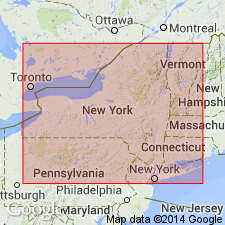
- Usage in publication:
-
- Cheektowaga Bentonite, First and Second
- Modifications:
-
- Named
- Dominant lithology:
-
- Bentonite
- Clay
- AAPG geologic province:
-
- Appalachian basin
Summary:
The Cheektowaga Bentonites, introduced by Conkin and Conkin (1979) in a field trip guide for the Ninth International Congress of Carboniferous Stratigraphy and Geology, are here formally presented in accordance with the North American Stratigraphic Code. The First Cheektowaga Bentonite occurs in the middle of the Moorehouse Member of the Onondaga Limestone, approximately 17 to 19 ft below its contact with the Seneca Member and 13 to 15 ft below the base of the Onondaga Indian Nation Bentonite (new name). The Second Cheektowaga Bentonite also occurs in the Moorehouse Member approximately 6 to 6.5 ft below its contact with the Seneca and about 2 to 2.5 ft below the base of the Onondaga Indian Nation Bentonite. The bentonites are indistinguishable except by stratigraphic position and paleontologic data. They are unctuous clays with prolific bleached biotite crystals. Both the First Cheektowaga and the Second Cheektowaga can be traced from their type locality in Erie Co. to Stafford in Genesee Co., and to the Onondaga Indian Nation 130 mi to the east. The Second Cheektowaga is also recognized at West Bowmans, PA. Age is Early Devonian (Onesquethawan).
Source: GNU records (USGS DDS-6; Reston GNULEX).
For more information, please contact Nancy Stamm, Geologic Names Committee Secretary.
Asterisk (*) indicates published by U.S. Geological Survey authors.
"No current usage" (†) implies that a name has been abandoned or has fallen into disuse. Former usage and, if known, replacement name given in parentheses ( ).
Slash (/) indicates name conflicts with nomenclatural guidelines (CSN, 1933; ACSN, 1961, 1970; NACSN, 1983, 2005, 2021). May be explained within brackets ([ ]).

